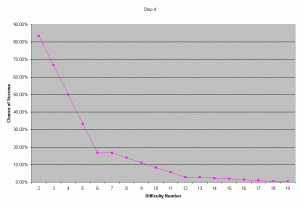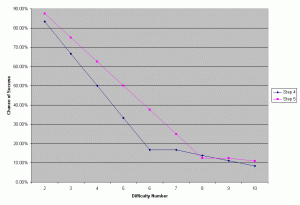Author’s note: These articles were written for the “original” step system, not the revisions introduced in Third Edition.
While the basics of the Step System are easy to grasp, its finer nuances are less intuitive than other role-playing game systems. This series of articles looks “under the hood” of the Earthdawn game, taking a closer look at the engine that drives it.
The Foundation: Single-Die Steps
While it is possible to calculate the chance of rolling any single result with a given step, the theoretically infinite number of bonus dice that are possible can make this difficult without calculus or computer programs—especially as you get into multiple-die steps. Fortunately, the chance of any single result is not as important as the chance of success against a given difficulty number, with the added benefit of being easier to calculate.
The chance of success a given step has against any Difficulty Number can be expressed as follows:
Number of successful results / Total possible results = Probability of success
Example: When rolling Step 4 (d6) against a Difficulty Number of 4 there are three successful results (4, 5, and 6) out of a total of six possible results—bonus dice don’t matter, because any bonus die results are still successful.
Therefore, the chance of success is:
3 / 6 = 0.5 (or 50%)
These calculations are simple enough for Difficulty Numbers less than (or equal to) the number of sides on the die, but what about higher difficulties? We just need to factor in the number of bonus dice required to achieve a successful result. For single-die steps you can do this by multiplying the base probability by (1 / nx), where n is number of sides on the die, and x is the number of bonus dice required. This factor gets multiplied by the chance of success on the final roll.
Example: To succeed against a Difficulty Number of 10 with a Step 4, we need to roll one bonus die, followed by a 4 or better. This makes n = 6, and x = 1. As shown in the previous example, the chance of rolling a 4 or better is (as shown above) 3 / 6. We plug the values into our formula:
1 / nx = 1 / 61 (or 1 / 6)
(1 / 6) x (3 / 6) = 3 / 36 = 0.0833 (or 8.33%)
If we calculate the chance of success for Step 4 against a series of increasing Difficulty Numbers, we get the following results:
| DN |
Chance of Success |
DN | Chance of Success | |
|
2 |
83.33% |
11 |
5.56% |
|
|
3 |
66.67% |
12 |
2.78% |
|
|
4 |
50.00% |
13 |
2.78% |
|
|
5 |
33.33% |
14 |
2.31% |
|
|
6 |
16.67% |
15 |
1.85% |
|
|
7 |
16.67% |
16 |
1.39% |
|
|
8 |
13.89% |
17 |
0.93% |
|
|
9 |
11.11% |
18 |
0.46% |
|
|
10 |
8.33% |
19 |
0.46% |
 If we enter these data points into a spreadsheet and graph them, we get the graph to the right. (Click the graph for a larger view.)
If we enter these data points into a spreadsheet and graph them, we get the graph to the right. (Click the graph for a larger view.)
I’d like to point out a couple of important and interesting details. First, the average result of the step is indicated by the 50% “break point”—you have an equal chance of success or failure at that point. As you can see, for Step 4 that break point falls at Difficulty Number 4. As mentioned in the Game Concepts chapter of the Earthdawn Player’s Compendium, the Step Number is also the average result for those step dice. This holds true for all Steps (though for many higher Steps, the average result does not have an exactly 50% chance of success, but is very close to it—we’ll see this in more detail later).
Second, we can see that the curve follows a repeating series of lines, with a regular plateau at the end of each series. Players of earlier editions of Shadowrun (or other games with ‘exploding’ dice) may recognize this trend—the chance of rolling one higher than the number of faces on the die are the same as rolling the max value on the die due. All of the single-die Steps show this trend.
 This relates to an interesting quirk of the single-die steps. If we graph the curve for Step 4 (d6) and Step 5 (d8) on the same chart, we get the following:
This relates to an interesting quirk of the single-die steps. If we graph the curve for Step 4 (d6) and Step 5 (d8) on the same chart, we get the following:
As you can see from the graph, you actually have a slightly better chance of success against a Difficulty Number of 8 with a Step 4 when compared to a Step 5—13.89% with Step 4, compared to 12.50% with Step 5. It isn’t a significant difference (only about 1.4%), but these little hiccups show up from time to time. We’ll see more of them as we dig deeper into the system.
